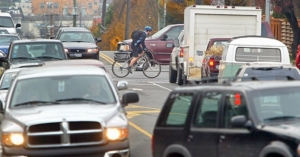Steve Wallace: A predictable path to better road safety

Predictable behaviour on the road is a key to safety, whether you are a motor-vehicle driver, cyclist or pedestrian.
Common sense seems all too uncommon in our traffic system. There are situations that should be easily understood, but appear to be a mystery to people using various means of transportation.
Pedestrians are the most vulnerable of all travellers. Given this simple fact, one would think they would be more attentive in our transportation system. Stop, look and listen, is often replaced with a sense of entitlement coupled with a lack of awareness.
The Walk signal means just that: There is allowable time to traverse a road. The Don’t Walk signal, flashing red, means the opposite. It does not mean “run.” If the authorities meant it to mean run, they would have flashed a Run signal. Walking gives drivers and cyclists a chance to use hazard-avoidance techniques.
Maybe we should replace these seemingly ineffective red flashing hand signals with a black Grim Reaper flashing picture. It might have more impact.
Is it too much to ask pedestrians to make eye contact with a person guiding the most efficient killing machine ever to be controlled by the average citizen? Walk facing traffic. It is a simple rule. Why would anyone turn their back on a motor missile heading their way? Sidewalks are not side cycles, nor side skateboards.
Separating bike traffic from roads dominated by motor vehicles is a good idea. Letting bike riders use the road when bike lanes are available is a bad idea. The average driver is likely to discount the presence of cyclists on the roadway when separated lanes are available. It might not be a required in the Motor Vehicle Act, but it is common sense to separate the two, for cycling safety.
Most cyclists are accomplished riders. It is uncommon to see them simply fall off for no good reason. They learn to stay out of motor-vehicle blind spots. Some, however, have never held a driver’s licence and are ignorant of the most rudimentary rules of the road. Cyclists always come off worse in confrontations with motor vehicles. It is common sense for them to stay behind vehicles turning, as opposed to being beside them.
Being extra visible is the common-sense solution for cyclists to be easily identified. More bikes on the road means fewer cars. One wonders why a cyclist would dress in black, without a light at night and not wear a helmet. This is proof of that common sense among some cyclists is all too uncommon — there must be some sort of death-wish cycle society. The ones who ride on sidewalks and against one-way traffic on city streets must have the same death wish as pedestrians who run, not walk, across streets.
Despite the odd behaviours of pedestrians and cyclists, it is drivers who noticeably display death-defying behaviours behind the wheel. Is it too much to ask that drivers come to a complete stop at a stop sign or when making a right turn on a red light? Others must be sent to us by some alien society wishing to confound everyone. Is it too much to ask that a driver wishing to turn left, at a multi-lane intersection, signal in advance, not after the traffic light change from red to green, trapping those behind? An amber light means stop. The two exceptions are when the vehicle driver has reached the point of no return or is in the intersection. Speeding in residential, school and playground areas is just plain dumb.
The common thread that dooms the three above mentioned modes of travel is the quick action. A pedestrian running across the street, a cyclist and vehicle driver going too fast for conditions, are all threats to life and limb. Doing the predictable is the best way to an accident-free existence.
Steve Wallace is the owner of Joan Wallace Driving School on Vancouver Island. He is a former vice-president of the Driving Schools Association of the Americas, a registered B.C.
teacher and a University of Manitoba graduate.


